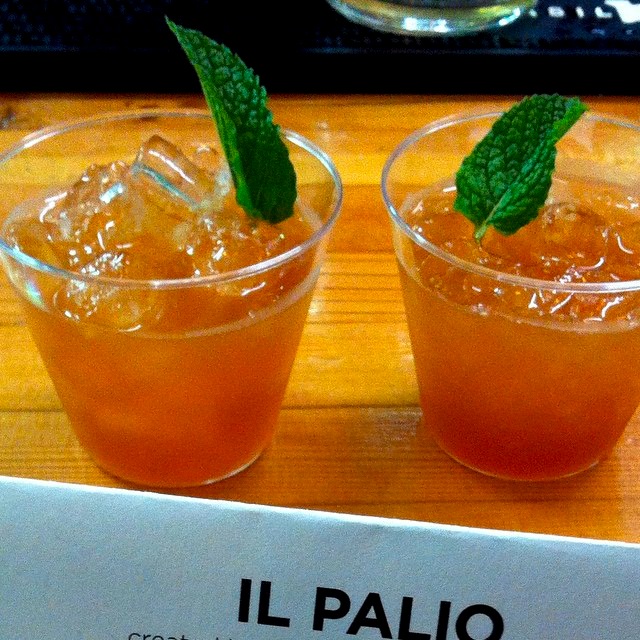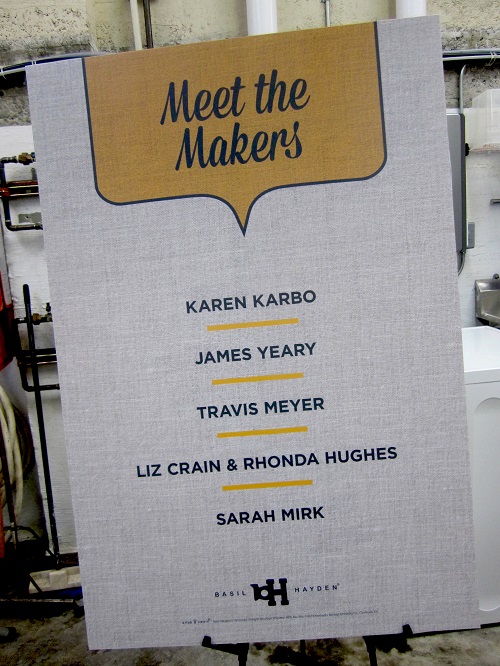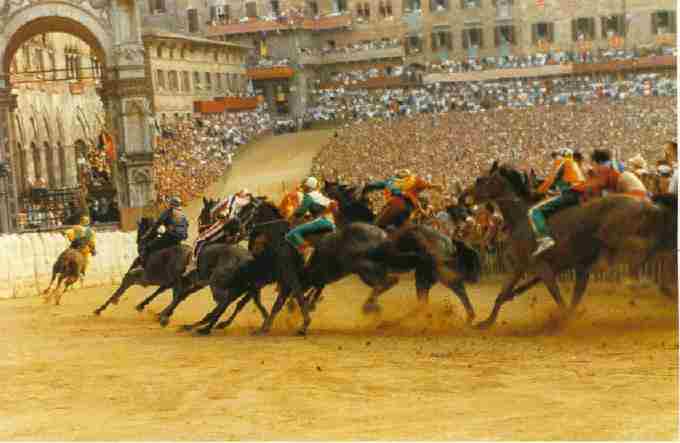The A.V. Club and Basil Hayden’s Bourbon have been doing a series of parties around the country celebrating cocktails and craftsman. Called This is My (Fill In Name of City Here), their idea was to get a bunch of really photogenic creative folks in one place, then film them as they powered down some fine cocktails, featuring Basil Hayden’s Bourbon (To the marketing person who thought this up, I hope you get a raise.) Each city showcased a group of “makers,” all practicing the same art form (Denver: “hand-crafted goods,” Nashville: music, Seattle, more music; Boston, artisanal food), who’d been asked to create something celebrating new cocktails made featuring Basil Hayden’s Bourbon. That’s a lot of artitude there — smart and cool party concept + fancy new cocktails + arty folks using said cocktails as inspiration. Portland was paired with indie lit, and I was asked to write anything that came to mind about one of three cocktails on offer. I chose Il Palio, named after the seriously crazy horse race held every summer in Siena.
The Legend of Il Palio, the Cocktail
Old Tomasso was the laughing stock of Siena. For twenty-five years he had purchased a horse and hired a jockey to run in the Palio, and for twenty-five years he had lost. It would not have been so terrible if the humiliation was merely personal, but his horse and rider represented his contrada, his neighborhood. The contrade were many centuries old, named after an animal, with a coat of arms, a motto, a mythology, and a shared trade. The Dragos, the dragons, were traditionally bankers. The leocorno, the unicorns, were goldsmiths. The Bruco, the caterpillers, worked in the silk trade. Old Tomasso’s contrada was the Lupa, the she-wolf, and even though Old Tomasso owned a bar, the trade associated with Lupa were bakers.
Every July 2 since 1644 the horses had raced. They ran three laps around the ancient Piazza del Campo. One minute fifteen seconds, that’s all it took to go down in history. The horses were mixed breed. Long ago it was decreed that the only thing special about them was that they be fast out of the gate, precise on the curve, calm in a crowd.
On July 1st of this particular year, the last year Old Tomasso would be purchasing a horse and hiring a rider to represent Lupa in the Palio, for he was very old and his lungs were bad, his jockey, Antonio Matteo, the celebrated Milanese playboy with the renowned dental work, marched into the bar and quit.
“The horse has lost his heart, and I refuse to bear the humiliation of losing,” said Antonio Matteo.
“I’m sure the horse is fine!” said Old Tomasso. “He is just conserving his energy.”
“His feet are bad,” said Antonio.
“I will pay you more!” cried Old Tomasso.
Antonio looked around the bar, at the chipped tile floor, the crooked pictures, the greasy windows, the few patrons. “There is not enough money in all of Siena to make me get on that horse.”
After he left, Old Tommaso thought he might cry. If Lupa lost the Palio thie year, his few customers would blame him for inflicting shame on the neighborhood AGAIN, and he would surely be forced to close his doors.
“I think I can help you,” said a young American sitting at the bar, drinking cheap beer and staring at the tiny screen on his telefonino.
There were two things that prevented Old Tomasso from throwing this American imbecile out of his bar: his bursitis was acting up, and he was desperate.
“You are a jockey?” asked Old Tomasso.
“I’ve never been on a horse, but I can win the race,” said the young American.
“You do know the jockeys ride bareback? ” said Old Tomasso.
“That’s what I’ve heard,” said the young American.
“And also, without stirrups,” said Old Tomasso.
“Just let me see the horse,” said the young American.
The horse lived in a stable only a few streets away. He was an unremarkable-looking bay, with a black mane and tail, and a white blaze shaped like Argentina. The horse’s stable was large and clean and when Old Tomasso brought the young American to see him, he stared, ears twitching, then slowly turned his back.
“He is showing you disrespect,” said Old Tomasso. “You will not even be able to mount him.”
“No worries,” said the young American. “But it’d be cool if I could feed him myself before the race.”
Old Tomasso had no choice but to trust the young American, and the next morning at feeding time, he brought him back to the stables and left him there. The day was warm and cloudy, uncharacteristic for Siena in July. The rituals of the day proceeded without incident. Old Tomasso’s young American and the horse were blessed by the Archbishop at City Hall, and the wall-eyed priest in the small church in Lupa contrada. “Go and be victorious!” intoned the priest. The horse yawned and shat in the aisle, and Old Tomasso’s spirit’s rose, for this was considered to be good luck.
Old Tomasso took his place in the viewing area, and after the speeches, the flag-waving demonstration, the procession of the banners, and what he was privately coming to view as the fucking endless hours of fucking pagentry, it was time for the race.
Most of the jockeys rode their horses out from the holding area, but the young American walked the horse out onto the track. He looked out of place in his silks, despite Lupa’s elegant colors, black and white with a bit of orange trim. A stable hand gave the young American a leg up, and as Old Tomasso watched him try to settle himself on the horse’s bare back, he saw that the young American had been telling the truth. He didn’t know one thing about riding a horse.
The horses snorted and pranced and pressed their chests against the starting rope. The spectators, tens of thousands of people seated in the viewing stands, crowded onto balconies, hanging out of windows, went quiet.
Suddenly, with a shot, they were off.
The horse lunged forward and the young American tumbled straight off his back and onto the dusty track. The horse, free of the American, bolted to the head of the field and stayed there, careening around each curve, breathing hard, certainly, but failing to break much of a sweat.
One of the most curious traditions of this most ancient of races, is that a riderless horse can still win, and Old Tomasso of Lupa’s horse won by many lengths. The citizens of Lupa were so delirious, they heaved Old Tomasso up and passed him around over their heads, and the old man laughed until he choked and had to be hospitalized. But he was okay after a day or two.
After Old Tomasso was released, he searched all of Siena for the young American, but he had vanished. He’d come off the back of the horse during the first second of the race, then disappeared into thin air. The horse’s performance had been extraordinary, magical even, and Old Tomasso tried to imagine how he had coaxed such speed from a horse that had lost heart. Then he remembered the young American’s request to visit the horse the morning of the race, and went to the stable, where he found a feeding pail in the corner of the horse’s stall. He stuck his old head in, gave it a sniff. It smelled like no horse mash he’d ever smelled in his entire life, earthy and minty, but not at all unpleasant.
Old Tomasso sought the help of a friend in Panther contrada, a chemist, who after performing some complicated tests, said, “It seems there is some ginger and artichoke, perhaps some mint. But the magical component was certainly a shot or two of Basil Hayden’s Bourbon, a light-bodied, rye-heavy whiskey with a buttery flavor and smooth finish.”
Old Tomasso had never heard of such a thing. But he wasn’t one to look a gift horse mash in the mouth. The triumph of Lupa contrada had restored his reputation, and business at the bar was better than ever. In honor of whatever it was that had caused his luck to turn, he created a special cocktail for the bar. And since he never knew the name of the young American, he called it simply Il Palio:

Il Palio, the tasty cocktail, created by mixologists Tyler Stevens and Sean Hoard, enjoyed every night in Portland since about last Wednesday.
1.5 parts Basil Hayden’s Bourbon
.75 part Cynar(r)
.5 part Punt e Mes
.5 part The Commissary(r) mint syrup
2 parts The Commissary(r) ginger beer
Today, every tourist who visits Siena finds their way to Old Tomasso’s bar and orders this drink.










